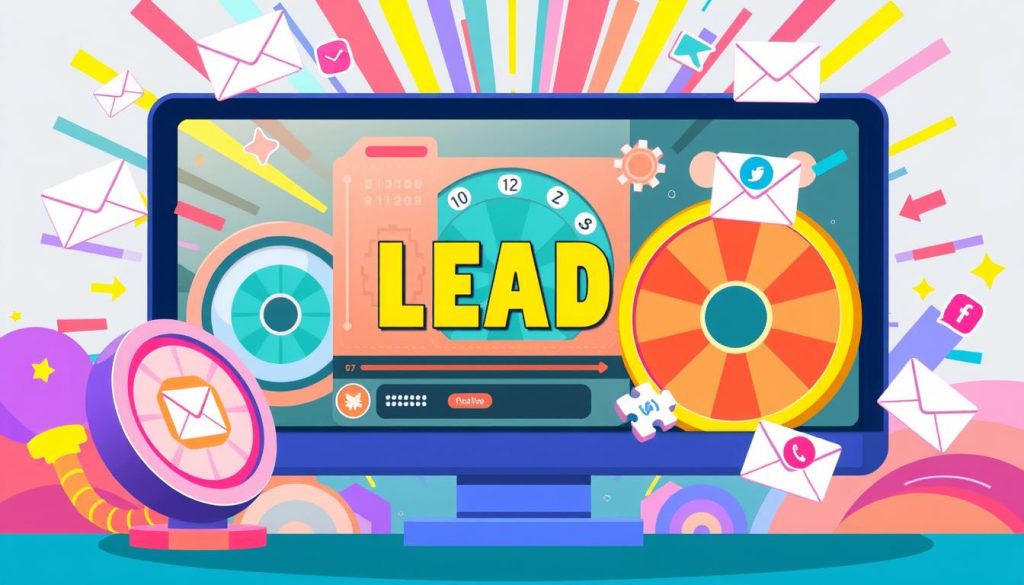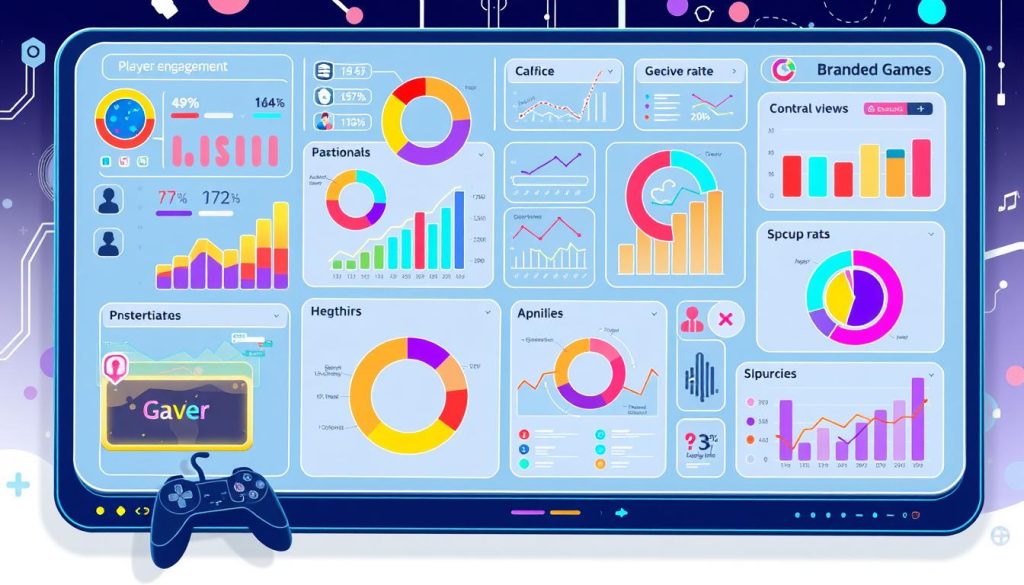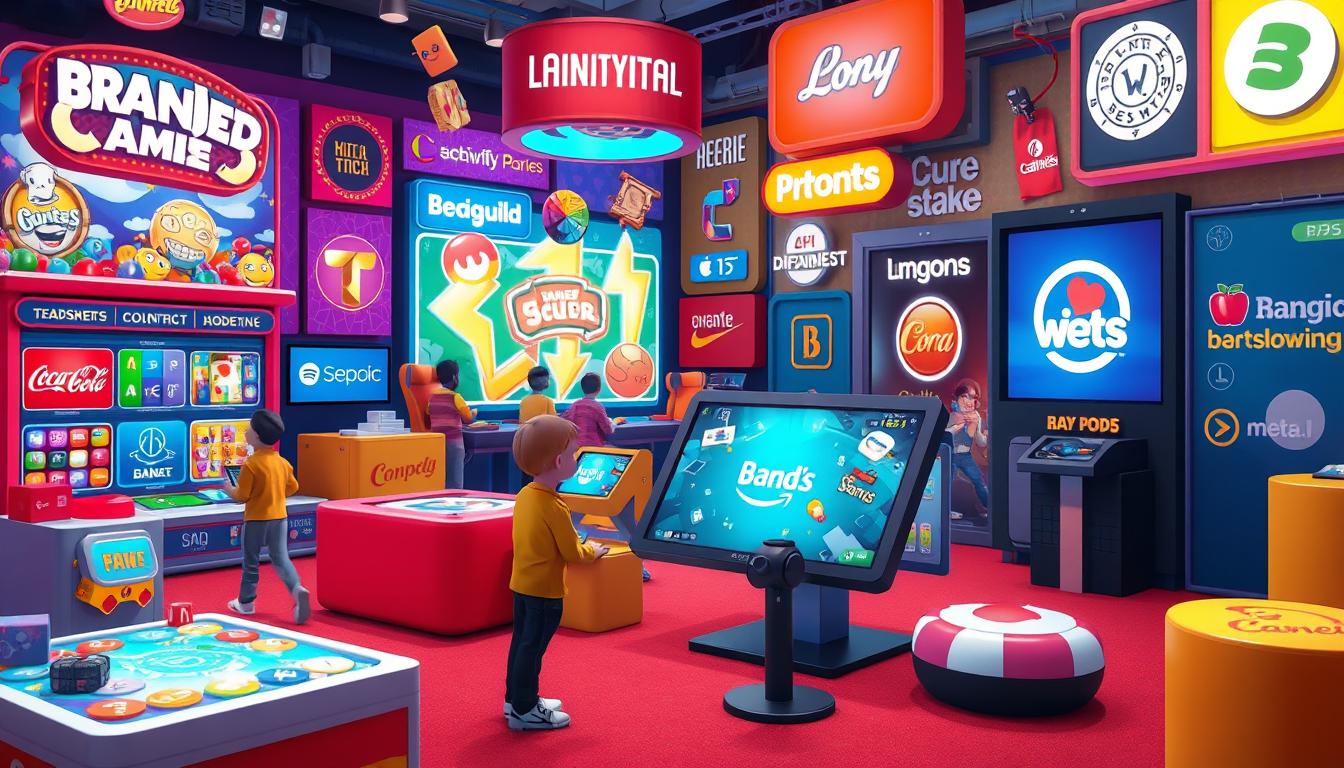In today’s digital world, businesses are always looking for new ways to grab their audience’s attention. Branded games have become a key marketing tool. They not only entertain but also help in generating leads, boosting brand awareness, and increasing loyalty.
Key Takeaways
- Branded games use gamification to create fun and memorable experiences for customers.
- These games are great for generating leads by collecting user info and nurturing potential customers.
- Branded games offer a chance to engage with your brand, build loyalty, and stand out in a crowded market.
- To make effective branded games, you need to understand user psychology, game mechanics, and marketing goals.
- Measuring success through engagement, conversion rates, and user retention helps improve future campaigns.
The Power of Gamification in Marketing
In the fast-changing world of marketing, gamification has become a key tool. It helps brands connect with customers and create lasting interactions. By using fun and competition, gamification makes experiences that grab attention and build brand loyalty.
Engaging Customers with Fun Experiences
Branded games and interactive experiences are changing how brands reach out to people. They offer fun and engaging ways to get customers involved. This approach boosts customer numbers and keeps users coming back. It uses experiential marketing to make moments that stick with people, strengthening the brand.
Boosting Brand Awareness and Loyalty
Branded games and gamified experiences do more than just grab attention. They also help build brand awareness and loyalty. By pulling customers into a brand’s world, these strategies create a strong bond. This bond leads to more engagement and loyalty to the brand.
“Gamification taps into our innate desire for competition, achievement, and social interaction, making it a powerful tool for marketers to create unforgettable brand experiences.”
The role of gamification in marketing will keep growing as digital spaces evolve. It offers brands new ways to engage their audience, attract new customers, and keep users coming back.
Branded Games: A New Frontier in Lead Generation
Brands are always looking for new ways to grab their audience’s attention and get valuable leads. Branded games have become a big hit in this area.
These games are a fun way to get people to interact with a brand. They let companies entertain their audience while also getting important customer data. This helps in growing potential leads.
Branded games are different from old marketing ways. They offer a deep and personal experience for users. This lets brands focus on their specific goals, like digital marketing strategies and conversion optimization.
One great thing about these games is they collect user data. This data helps brands improve their marketing. It makes content more personal and boosts lead generation and conversion optimization.
Also, branded games can make a brand more known and loved. They offer a fun and memorable experience. This builds a strong bond with the audience, leading to loyal customers.
“Branded games have the power to transform the way we think about lead generation, blending entertainment and marketing in a way that resonates with today’s digital-savvy consumers.”
As digital marketing strategies keep changing, branded games are a new path for lead generation and conversion optimization. They use interactive experiences to connect with the audience in a unique way. This leads to better business results.
Understanding the Psychology of Branded Games
The secret to Gamification success in marketing is tapping into human motivations. By knowing what drives user engagement, brands can make Immersive Experiences. These experiences keep users coming back and help attract new customers.
Tapping into Human Motivations
Branded games tap into our desire for achievement, competition, and connection. As players progress, they feel a sense of accomplishment. This feeling releases dopamine, making us feel good.
This positive feedback loop keeps users playing. It strengthens their connection to the brand.
Creating Immersive and Memorable Experiences
Great branded games draw players into stunning, interactive worlds. They use storytelling and game mechanics to create unforgettable experiences. These experiences leave a mark on the audience.
This not only keeps users coming back but also builds a strong emotional bond. This bond can lead to more Customer Acquisition and loyalty.
Gamification lets brands use psychology to create impactful experiences. By understanding and using these insights, marketers can make branded games truly effective. They can drive engagement, User Retention, and Customer Acquisition.
Interactive Marketing: How Branded Games Generate More Leads
Branded games are changing digital marketing. They use gamification to grab attention and create real engagement. This approach helps businesses stand out and build a loyal customer base.
Branded games build a strong connection with the audience. When people play games that match a brand’s values, they feel closer to it. This leads to more loyalty and better brand awareness.
These games tap into our love for fun and winning. They offer rewards that keep players interested. This way, businesses can lead people to discover and convert.

Branded games also give insights into what people like. By watching how users play, businesses learn a lot. This helps them make their marketing even better.
In today’s world, where everyone is busy, branded games are a great way to get noticed. They offer a fun way to engage with customers. This can lead to more leads and help businesses grow.
Designing Effective Branded Games
Creating engaging branded games needs a smart plan. It must match game mechanics with marketing objectives. By designing game elements well, marketers can use gamification to grab attention, build brand engagement, and boost conversion optimization.
Aligning Game Mechanics with Marketing Goals
The secret to great branded games is blending game mechanics with marketing aims. Marketers should keep these key points in mind:
- Immersive Experiences: Make immersive experiences that pull players into the brand’s world. This makes the interaction memorable and fun.
- Reward Structures: Use game mechanics like points, leaderboards, and achievements to motivate players. This encourages them to play more and come back.
- Storytelling: Tell a story that speaks to the audience. Make sure it matches the brand’s values and the game’s theme.
- Interactivity: Make the game interactive. Use easy controls and quick feedback to make players feel in control and curious.
- Data-Driven Optimization: Keep checking how players act and how the game does. Use this data to make the game better and more fun.
By following these design tips and matching them with marketing goals, brands can make branded games. These games can grab the audience’s attention, increase brand engagement, and help with conversion and lead generation.
Measuring the Success of Branded Games
It’s key to check how well branded games work for lead generation, user retention, conversion optimization, and digital marketing strategies. By looking at important metrics and analytics, companies can learn a lot. This helps them see how good their interactive marketing is.
Key Metrics for Lead Generation and Engagement
There are important metrics to watch when checking branded game success:
- Lead Capture Rate: This shows how many users give their contact info, like email or phone number, while playing.
- Conversion Rate: This is how many players do what you want them to, like buying something or signing up, after playing.
- User Engagement: Look at how many finish the game, how long they play, and if they come back. This shows if the game grabs and keeps people’s interest.
- Social Sharing: Count how many players share the game on social media. This shows how much people talk about and support your brand.
| Metric | Description | Relevance |
|---|---|---|
| Lead Capture Rate | Percentage of users who provide contact information | Measures the effectiveness of the game in generating leads |
| Conversion Rate | Percentage of players who take a desired action | Evaluates the game’s ability to drive conversions |
| User Engagement | Metrics like game completion, session duration, and retention | Assesses the game’s ability to capture and hold audience attention |
| Social Sharing | Number of players who share the game on social media | Indicates the level of brand awareness and advocacy generated |
By watching these key metrics closely, companies can learn a lot. They can see how well their branded games work. This helps them make smart choices to improve their lead generation, user retention, and conversion optimization plans.

“Measuring the success of branded games is essential for understanding their impact on your marketing objectives and making informed decisions about your interactive marketing strategies.”
Successful Case Studies of Branded Games
Branded games are a key tool in interactive marketing. They help drive customer acquisition, brand engagement, and create immersive experiences. By using gamification, brands can grab their audience’s attention and see great results.
Coca-Cola’s “Happiness Machine” Campaign
Coca-Cola’s “Happiness Machine” campaign is a great example. It featured a vending machine that gave out fun surprises. This campaign aimed to spread joy and delight among people. It made the brand more relatable and built strong emotional bonds.
Frito-Lay’s “Crash the Super Bowl” Contest
Frito-Lay’s “Crash the Super Bowl” contest was a contest for Doritos ads. Fans could submit their own commercials, and the best ones aired during the Super Bowl. This campaign increased brand engagement and made the brand more visible.
| Campaign | Industry | Key Objectives | Results |
|---|---|---|---|
| Coca-Cola’s “Happiness Machine” | Beverage | Boost brand awareness, create emotional connections | Increased brand engagement, positive brand sentiment |
| Frito-Lay’s “Crash the Super Bowl” | Snack Food | Generate fan-created content, amplify brand visibility | Increased brand engagement, user-generated content |
These examples show how branded games can help with customer acquisition, brand engagement, and immersive experiences. By tapping into our love for play, brands can connect with their audience in meaningful ways.
Integrating Branded Games with Other Digital Marketing Strategies
In the fast-changing world of digital marketing, combining branded games with other tactics is crucial. This blend can lead to amazing results. It helps businesses in lead generation, brand engagement, and user retention.
Using Digital Marketing Strategies, brands can make their games more effective. They can use social media like Facebook, Instagram, and TikTok. This way, they can share engaging content that people love to share, boosting brand engagement and lead generation.
Branded games can also spice up email marketing. Adding game elements to emails can make them more interesting. This can lead to more people opening and clicking on emails, helping with user retention. It also gives valuable data to improve marketing.
“Branded games are no longer a standalone marketing tactic – they are a powerful tool that can be seamlessly woven into the fabric of a brand’s digital ecosystem.”
Branded games can also work well with websites and mobile apps. When they’re part of a bigger digital plan, they offer a complete experience. This approach helps businesses achieve their goals in lead generation, brand engagement, and user retention.
Best Practices for Branded Game Development
Making great branded games means knowing a lot about how people play and what makes games fun. It also involves understanding marketing well. By following the best ways to do this, companies can make games that keep players coming back and help grow their business.
Tips for Creating Engaging and Successful Experiences
To make branded games that grab users’ attention and meet marketing goals, keep these tips in mind:
- Use Gamification elements: Add things like points, leaderboards, and rewards to keep players interested and coming back.
- Make the game immersive: Create a game world that looks great and pulls players in, leaving a strong impression of the brand.
- Match the game with your marketing goals: Make sure the game has ways to capture leads, show off products, and encourage actions that help your business.
- Keep testing and improving: Watch how players behave, listen to what they say, and use that info to make the game better and more effective.
- Share the game everywhere: Use social media, email, and other online places to get the game seen by more people.
| Key Metric | Description | Importance |
|---|---|---|
| Gamification | Looks at how game-like features help keep players interested and coming back. | Very important for seeing how Gamification affects the game’s success and your marketing goals. |
| Immersive Experiences | Checks how well the game grabs and holds the player’s attention. | Key to building brand awareness and loyalty through a memorable game experience. |
| Conversion Optimization | Tracks how well the game gets players to take actions like generating leads or making purchases. | Crucial for seeing how the game helps meet your brand’s marketing and sales goals. |
By following these best practices, companies can make branded games that draw in players, keep them engaged, and help achieve their marketing goals.
“Successful branded games blend Gamification, Immersive Experiences, and Conversion Optimization to make a powerful marketing tool.”
The Future of Branded Games and Interactive Marketing
Technology and what people want are changing fast. This means big things for branded games and interactive marketing. Brands are using gamification to make fun, engaging experiences. These experiences grab people’s attention and help get more leads.
Experts say that mixing digital marketing strategies with games will be key to success. New tech like augmented and virtual reality will let brands create amazing, interactive worlds. These worlds will feel real and exciting.
People want more fun and personal experiences with brands. So, the future of branded games will focus on creating immersive experiences. These experiences will make people feel closer to the brand. By tapping into what people love, brands can build loyalty, get more people to know about them, and get lots of good leads.
FAQ
What is the role of branded games in lead generation?
Branded games are a key tool for businesses to engage customers. They offer fun and interactive ways to connect with people. This approach captures attention, builds loyalty, and boosts lead generation and conversion rates.
How do branded games boost brand awareness and customer loyalty?
Branded games create memorable experiences that boost brand engagement and loyalty. They tap into human desires like achievement and social connection. This builds strong emotional bonds between the brand and its audience, increasing awareness and retention.
What are the key benefits of incorporating branded games into a digital marketing strategy?
Branded games bring many benefits for businesses aiming to increase leads and marketing success. They attract and engage potential customers, gather valuable data, and nurture leads. By adding to traditional strategies, they enhance conversion rates and support customer acquisition and retention.
How do branded games tap into the psychology of human behavior?
Branded games are effective because they tap into human motivations. They use game mechanics that trigger achievement, social connection, and competition. This creates immersive experiences that engage customers deeply, based on psychological understanding.
What are the key metrics for measuring the success of branded games?
Success in branded games is measured by key metrics like lead capture rates and user engagement. Businesses should also track conversion rates and customer retention. Monitoring these metrics helps optimize game strategies for better lead generation.
What are some best practices for designing effective branded games?
Designing successful branded games requires a strategic approach. Key practices include clear calls-to-action and a seamless user experience. Personalizing the game experience with data insights and integrating it with other marketing channels are also crucial.
What is the future outlook for branded games and interactive marketing?
The future of branded games and interactive marketing looks promising. Trends like augmented reality and virtual reality will shape how brands engage customers. These advancements will influence how gamification drives business growth in the coming years.


